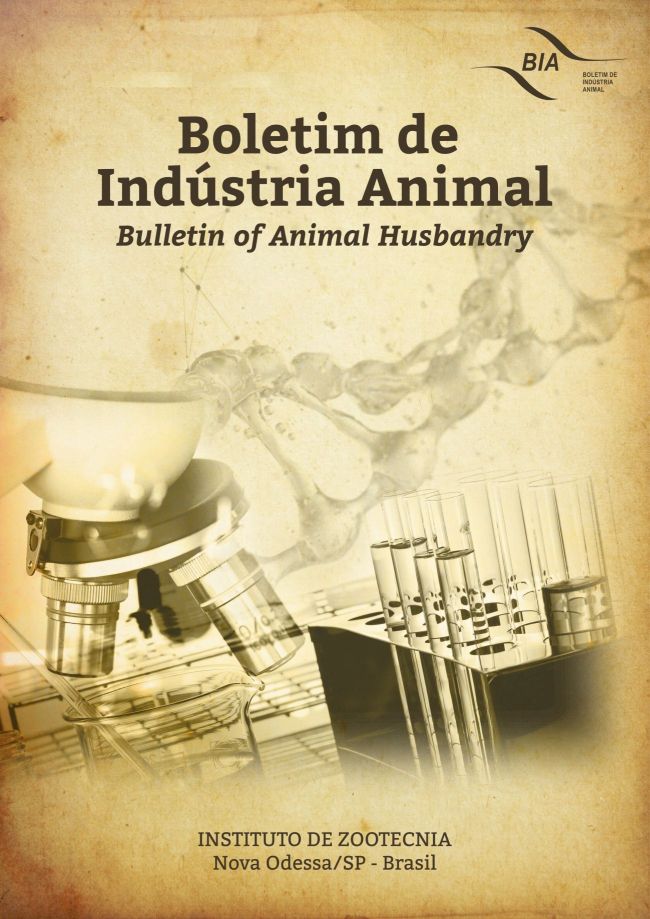Metabolizable energy for broilers with different genetic growth potentials under a free-range system
DOI:
https://doi.org/10.17523/bia.2018.v75.e1420Palavras-chave:
carcass characteristics, energy protein ratio, fast-growing, performance, slow-growingResumo
The objective of this study was to evaluate the effects of different levels of metabolizable energy (ME) on performance parameters and carcass characteristics in slow-growing (experiment 1) and fast-growing (experiment 2) broilers in a free-range system. Were evaluated broilers from 35 to 70 days old in experiment 1 and 28 to 49 days old in experiment 2. A completely randomized experimental design was employed in both experiments, with five treatments and four replicates totaling 20 experimental units containing 15 broilers each. The treatments consisted of rations that had increasing metabolizable energy levels obtained by the substitution of soybean oil in the basal diet for the inert sand ingredient. The metabolizable energy levels studied in experiment 1 were 2700, 2800, 2900, 3000 and 3100 kcal/kg, and in experiment 2, they were 2800, 2900, 3000, 3100 and 3200 kcal/kg. In experiment 1, there was a linear (P<0,05) reduction in consumption
with the increase in the metabolizable energy level, and a quadratic effect (P<0,05) on the feed conversion was observed, which was estimated as 3046 kcal/kg the level that resulted in a better feed conversion of 2.648. In experiment 2, the metabolizable energy level exerted a significant quadratic effect (P<0,05) on the feed intake and metabolizable energy consumption, with a maximum feed intake (3361.27 g) estimated for 2842 kcal/kg, and the maximum energy intake was estimated at 10020 kcal. The feed conversion decreased linearly (P<0,05) with there was an increase in the studied levels. For broilers reared in a free-range system, for better feed conversion, the recommended metabolizable energy levels are as follows: for slow-growing broilers from 35 to 70 days of age, 3046 kcal/kg, and 3200 kcal/kg is recommended for fast-growing broilers from 28 to 49 days of age.
Downloads
Downloads
Publicado
Edição
Seção
Licença
Os autores não serão remunerados pela publicação de trabalhos, pois devem abrir mão de seus direitos autorais em favor deste periódico. Por outro lado, os autores ficam autorizados a publicar seus artigos, simultaneamente, em repositórios da instituição de sua origem, desde que citada a fonte da publicação original seja Boletim de Indústria Animal. A revista se reserva o direito de efetuar, nos originais, alterações de ordem normativa, ortográfica e gramatical, com vistas a manter o padrão culto da língua e a credibilidade do veículo. Respeitará, no entanto, o estilo de escrever dos autores. Alterações, correções ou sugestões de ordem conceitual serão encaminhadas aos autores, quando necessário. Nesses casos, os artigos, depois de adequados, deverão ser submetidos a nova apreciação. As opiniões emitidas pelos autores dos artigos são de sua exclusiva responsabilidade. Todo o conteúdo deste periódico, exceto onde está identificado, está licenciado sob a Licença Creative Commons Attribution (CC-BY-NC). A condição BY implica que os licenciados podem copiar, distribuir, exibir e executar a obra e fazer trabalhos derivados com base em que só se dão o autor ou licenciante os créditos na forma especificada por estes. A cláusula NC significa que os licenciados podem copiar, distribuir, exibir e executar a obra e fazer trabalhos derivados com base apenas para fins não comerciais.













